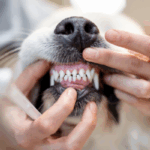How does the heart work?
The heart has four chambers. Two upper chambers (Left & Right Atrium) and two lower chambers (Left & Right Ventricle).
 Blood flows FROM the body into the right atrium, then pumped into the right ventricle.
Blood flows FROM the body into the right atrium, then pumped into the right ventricle.
The right ventricle pumps the bloods into the lungs where is receives oxygen.
It then flows from the lungs into the left atrium, then into the left ventricle.
The left ventricle contains the largest muscle of the heart so the blood can then be pumped out to all parts of the body.
There are TWO types of heart disease. Mitral Valve Disease and Dilated Cardiomyopathy.
Dilated Cardiomyopathy (DCM) is a condition of the heart when the heart muscle becomes unable to function properly. It is weak and unable to contract effectively, reducing the flow of blood to the body. This leads to a back up of fluid within the heart causing it to enlarge.
This particular type of heart disease is the most common cause of heart failure in larger dogs.
Mitral Valve Disease: What is the mitral valve? Each side of the heart has a valve to keep blood from going backward from the ventricles to the atria. This is called the mitral valve. In some dogs, the tissue in this valve thickens and becomes uneven, allowing blood to leak back into the atria causing a heart murmur which can be heard using a stethoscope. Mitral Valve disease is the most common cause of heart failure in small dogs.
Clinical signs occur when the heart starts to fail. Things to look out for include:
Decreased exercise tolerance
An enlarged abdomen
Coughing
Weight lossor poor appetite
Fainting or collapsing may be seen in severe cases
There are several tests that we can use to diagnose your pet and provide valuable information on different aspects of your pets heart.
 AUSCULATION: Listening to your pets heart with a stethoscope. This can help us identify any murmurs that are present, where they are in the heart and their intensity.
AUSCULATION: Listening to your pets heart with a stethoscope. This can help us identify any murmurs that are present, where they are in the heart and their intensity.
BLOOD & URINE TESTS: These do not give direct information about heart function, but instead allow us to detect any other disorders your pet may have that may be significant to his/her heart function.
RADIOGRAPHS: The chest radiograph is useful for examining the lungs and for viewing the size and shape of the heart. Chest radiographs are the best way to detect early fluid build up within the lungs.
ECG (ELECTROCARDIOGRAM): THis is an assessment of the electrical activity of the heart. It allows accurace determination of the heart rate and rhythm.
ECHOCARDIOGRAM (ULTRASOUND): This test uses sound waves which bound off the structures of the heart and are read on a TV-like monitor. It gives the best look at the size of each heart chamber, and permits visualization of the heart valves.
We will inform you of the most useful combination of these tests to assess your pets cardiovascular health.
 There are a number of medications available which can help improve the function of the heart and reduce fluid overload. These medications so far have only been shown to be helpful once the heart is failing. No treatment to prevent the onset of heart failure has been identified.
There are a number of medications available which can help improve the function of the heart and reduce fluid overload. These medications so far have only been shown to be helpful once the heart is failing. No treatment to prevent the onset of heart failure has been identified.
If you think your pet’s heart health may be causing them problems, please do not hesitate to contact us on 9878 3033.






